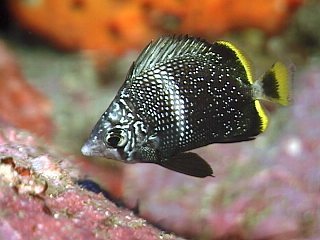
Wrought Iron Butterflyfish
The Atlantic Bluefin Tuna (Thunnus thynnus) is a magnificent and highly migratory species of tuna. It's renowned for its size, speed, and economic value, particularly in the sushi market. This apex predator plays a critical role in the marine ecosystem.
10 15 years
Lifespan
15 cm
Length
Least Concern
Conservation Status
10 km/h
Swimming speed
Omnivorous
Diet
Local Migration
Migration
Appearance Overview
The Atlantic Bluefin Tuna is renowned for its large, streamlined body, built for speed and endurance in the open ocean.
Color
Dark metallic blue above and silvery white below, providing effective camouflage.
Fins
Two dorsal fins, the first depressible into a groove; a series of small finlets behind the second dorsal and anal fins.
Body Shape
Torpedo-shaped, designed for efficient swimming.
Length
Typically up to 10 feet (3 meters), but can reach up to 13 feet (4 meters).
Weight
Commonly around 550 lbs (250 kg), but can reach up to 1,500 lbs (680 kg).
Diet
Carnivorous, feeding on a variety of fish, squid, crustaceans, and occasionally, zooplankton and eels.
Feeding Behavior
Aggressive predator that uses its speed to chase down prey. They often hunt in coordinated schools, especially when younger.
Social Behavior
Highly migratory, forming large schools based on size rather than age. They exhibit complex social behaviors during spawning.
Commercial Relevance
Extremely high value, particularly in the sushi and sashimi markets of Japan. The meat is prized for its flavor, texture, and fat content.
Conservation measures
Subject to strict international fishing quotas, marine protected areas, and monitoring programs. Efforts are ongoing to improve stock management and reduce illegal fishing.
Status
Endangered (Varies by region; some populations are more depleted than others).
Threats
Overfishing is the primary threat. Other threats include bycatch in fishing gear, habitat degradation, and climate change affecting prey distribution.
Habitat Distribution
Depth Range
Typically found from the surface to depths of 500-1,000 meters, depending on the season and location.
Geographic Range
Western and Eastern Atlantic Ocean, including the Mediterranean Sea. They are notably absent from the Black Sea.
Preferred Environment
Prefers temperate and subtropical waters. They are pelagic, inhabiting the open ocean.
Reproduction and Life Cycle
Breeding Habits
Spawns in warm waters, primarily in the Mediterranean Sea and the Gulf of Mexico. Spawning typically occurs from May to July.
Development Stages
Eggs are pelagic and hatch within a few days. Larvae are planktonic and undergo rapid growth, developing into juveniles that resemble miniature adults.
Fecundity
Highly fecund; a single female can produce up to 30 million eggs per spawning season, depending on her size and condition.
Maturity Age
Reaches sexual maturity at around 4-8 years of age, although this can vary slightly between the western and eastern Atlantic populations.
Faqs about Wrought Iron Butterflyfish
Where are Atlantic Bluefin Tuna found?
Atlantic Bluefin Tuna are found in the Atlantic Ocean, from Newfoundland to the Gulf of Mexico in the west, and from Norway to the Mediterranean Sea in the east.
How long do Atlantic Bluefin Tuna live?
They can live up to 40 years, although the average lifespan is around 15-25 years in the wild.
Are Atlantic Bluefin Tuna migratory?
Yes, they are highly migratory, traveling vast distances across the Atlantic Ocean for feeding and spawning.
How fast can Atlantic Bluefin Tuna swim?
Atlantic Bluefin Tuna are among the fastest fish in the ocean, capable of bursts of speed up to 43 mph (70 km/h).
When do Bluefin Tuna reach maturity?
They typically reach sexual maturity between 4-8 years of age, depending on the population.
Copyright @ Nature Style Limited. All Rights Reserved.
 English
English